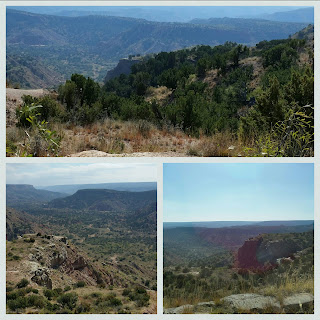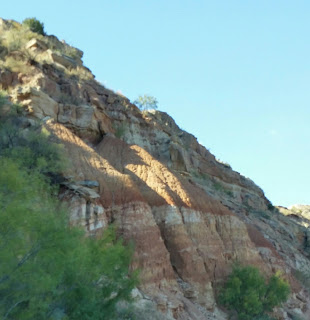We woke up to a cloudy day that turned beautiful and sunny by around 11:00am. After a couple cups of coffee and breakfast we decided to take a ride over to Palo Duro Canyon State Park.
"Palo Duro" is Spanish for "hard wood" in reference to the Juniper trees common throughout the canyon. The canyon is approximately 120 miles long and 600 to 800 feet deep and is the second largest canyon in the United States. The canyon was formed less than 1 million years ago when the Prairie Dog Town Fork of the Red River first carved its way through the Southern High Plains. The rocks expose a geologic story which began approximately 250 million years ago, layer by layer revealing a panoramic view of magnificent color. The canyon's archeological and ethnological treasures suggest about twelve thousand years of human habitation, rising and waning as climate varied among periods of abundant moisture, aridity, and sometimes fearful drought.
It is called the "Grand Canyon of Texas" and consists of 18,438 acres in Randall and Armstrong counties including the recently purchased 2,036 acre Canoncita Ranch. The original park land was deeded by private owners in 1933.
From 1933 until 1937 the Civilian Conservation Corps sent seven companies of young men and military veterans to Palo Duro Canyon to develop road access to the canyon floor and build the visitor center, cabins, shelters and the park headquarters. Work on the one and a half mile road from the rim to the floor of the canyon began in August 1933. While difficult areas were blasted with dynamite, the vast majority of the work was done with hand tools such as picks, shovels, and wheelbarrow. In less then six months these men succeeded in creating the first vehicle access to the canyon floor. (Members of the CCC were paid $1 per day.) The road, which is still in use today, was officially opened on November 26, 1933.
Although much hard work remained to be done the park officially opened on July 4, 1934.
(The above information was taken from a park brochure
and information found at the Visitor Center.)
 |
| Now the Entrance Office to the park it was first known as the Toll House. |
 |
| The road going into the park. |
 |
| Taken from the rim of the Canyon near the Visitor Center. |
 |
| The road down to the floor of the canyon. |
 |
| Natures own balancing act. |
Pictures taken as we drove through the park. I could have taken hundreds it was so beautiful. I only wish I had a better camera. I know these pictures do not capture the beauty of this place. Though I am not sure any picture could capture the colors the eye sees as you take in the vistas surrounding you.
 |
| Even in the State Park there is road construction. |
Nature is painting for us, day after day,
pictures of infinite beauty.
~John Ruskin

















No comments:
Post a Comment